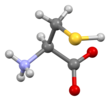
Back سيستئين Arabic سیستئین AZB Цыстэін Byelorussian Цыстэін BE-X-OLD Цистеин Bulgarian Cistein BS Cisteïna Catalan Cystein Czech Cystein Danish Cystein German
 Skeletal formula of L-cysteine
| |||
| |||
| Names | |||
|---|---|---|---|
| IUPAC name
Cysteine
| |||
Other names
| |||
| Identifiers | |||
3D model (JSmol)
|
|||
| Abbreviations | Cys, C | ||
| ChEBI | |||
| ChEMBL | |||
| ChemSpider | |||
| ECHA InfoCard | 100.000.145 | ||
| EC Number |
| ||
| E number | E920 (glazing agents, ...) | ||
| KEGG | |||
PubChem CID
|
|||
| UNII |
| ||
CompTox Dashboard (EPA)
|
|||
| |||
| |||
| Properties[3] | |||
| C3H7NO2S | |||
| Molar mass | 121.15 g·mol−1 | ||
| Appearance | white crystals or powder | ||
| Melting point | 240 °C (464 °F; 513 K) decomposes | ||
277g/L (at 25 °C)
[1] | |||
| Solubility | 1.5g/100g ethanol 19 °C [2] | ||
Chiral rotation ([α]D)
|
+9.4° (H2O, c = 1.3) | ||
| Supplementary data page | |||
| Cysteine (data page) | |||
Except where otherwise noted, data are given for materials in their standard state (at 25 °C [77 °F], 100 kPa).
| |||
Cysteine (symbol Cys or C;[4] /ˈsɪstɪiːn/)[5] is a semiessential[6] proteinogenic amino acid with the formula HOOC−CH(−NH2)−CH2−SH. The thiol side chain in cysteine often participates in enzymatic reactions as a nucleophile. Cysteine is chiral, but interestingly, both D and L-cysteine are found in nature with D-cysteine having been found in developing brain (see Semenza et al., 2021). Cysteine is named after its discovery in urine, which comes from the urinary bladder or cyst, from kystis "bladder".[7]
The thiol is susceptible to oxidation to give the disulfide derivative cystine, which serves an important structural role in many proteins. In this case, the symbol Cyx is sometimes used.[8][9] The deprotonated form can generally be described by the symbol Cym as well.[9][10]
When used as a food additive, cysteine has the E number E920.
Cysteine is encoded by the codons UGU and UGC.
- ^ "PubChem data".
- ^ Belitz, H.-D; Grosch, Werner; Schieberle, Peter (2009-02-27). Food Chemistry. Springer. ISBN 9783540699330.
- ^ Weast, Robert C., ed. (1981). CRC Handbook of Chemistry and Physics (62nd ed.). Boca Raton, FL: CRC Press. p. C-259. ISBN 0-8493-0462-8..
- ^ "Nomenclature and symbolism for amino acids and peptides (IUPAC-IUB Recommendations 1983)", Pure Appl. Chem., 56 (5): 595–624, 1984, doi:10.1351/pac198456050595
- ^ "cysteine - Definition of cysteine in English by Oxford Dictionaries". Oxford Dictionaries - English. Archived from the original on September 25, 2016. Retrieved 15 April 2018.
- ^ "The primary structure of proteins is the amino acid sequence". The Microbial World. University of Wisconsin-Madison Bacteriology Department. Archived from the original on 25 May 2013. Retrieved 16 September 2012.
- ^ Saffran, M. (April 1998). "Amino acid names and parlor games: from trivial names to a one-letter code, amino acid names have strained students' memories. Is a more rational nomenclature possible?". Biochemical Education. 26 (2): 116–118. doi:10.1016/s0307-4412(97)00167-2. ISSN 0307-4412.
- ^ "Amber Workshop - Tutorial A1 - Section 1: Do some editing of the PDB file". ambermd.org. Archived from the original on 2022-05-22. Retrieved 2022-06-02.
- ^ a b Lee, Jumin; Hitzenberger, Manuel; Rieger, Manuel; Kern, Nathan R.; Zacharias, Martin; Im, Wonpil (21 July 2020). "CHARMM-GUI supports the Amber force fields". The Journal of Chemical Physics. 153 (3): 035103. doi:10.1063/5.0012280. PMID 32716185. S2CID 220796795.
- ^ "Amber Workshop - Tutorial A1 - Section 1: Do some editing of the PDB file". ambermd.org. Archived from the original on 2022-05-22. Retrieved 2022-06-02.
© MMXXIII Rich X Search. We shall prevail. All rights reserved. Rich X Search

